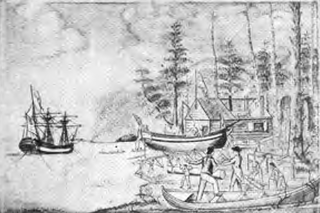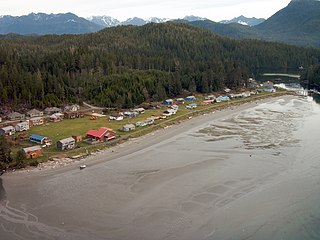
The Pacific Fur Company (PFC) was an American fur trade venture wholly owned and funded by John Jacob Astor that functioned from 1810 to 1813. It was based in the Pacific Northwest, an area contested over the decades between the United Kingdom of Great Britain and Ireland, the Spanish Empire, the United States of America and the Russian Empire.

The Tla-o-qui-aht First Nations are a Nuu-chah-nulth First Nation in Canada. They live on ten reserves along the Pacific Rim National Park Reserve on Vancouver Island, British Columbia. The band is part of the Nuu-chah-nulth Tribal Council. There were 618 people living in the Tla-o-qui-aht reserves in 1995. Their primary economic activities are fishing and tourism.

Fort Astoria was the primary fur trading post of John Jacob Astor's Pacific Fur Company (PFC). A maritime contingent of PFC staff was sent on board the Tonquin, while another party traveled overland from St. Louis. This land based group later became known as the Astor Expedition. Built at the entrance of the Columbia River in 1811, Fort Astoria was the first American-owned settlement on the Pacific coast of North America.
Jonathan Thorn was a career officer of the United States Navy in the early 19th century.

Tonquin was a 290-ton American merchant ship initially operated by Fanning & Coles and later by the Pacific Fur Company (PFC), a subsidiary of the American Fur Company (AFC). Its first commander was Edmund Fanning, who sailed to the Qing Empire for valuable Chinese trade goods in 1807. The vessel was outfitted for another journey to China and then was sold to German-American entrepreneur John Jacob Astor. Included within his intricate plans to assume control over portions of the lucrative North American fur trade, the ship was intended to establish and supply trading outposts on the Pacific Northwest coast. Valuable animal furs purchased and trapped in the region would then be shipped to China, where consumer demand was high for particular pelts.

Robert Stuart was a Scottish-born, Canadian and American fur trader, best known as a member of the first European-American party to cross South Pass during an overland expedition from Fort Astoria to Saint Louis in 1811. He was a member of the North West Company (NWC) until recruited by John Jacob Astor to develop the new Pacific Fur Company, which was based at Fort Astoria, on the coast of present-day Oregon. Astor intended the venture to develop a continent-wide commercial empire in fur trading.

Fort Defiance was a small outpost that the crew of the Columbia Rediviva built as winter quarters during 1791–1792 on Meares Island in present-day British Columbia, Canada. American merchant and maritime fur trader Captain Robert Gray was in command.
Alexander MacKay was a Canadian fur trader and explorer who worked for the North West Company and the Pacific Fur Company. He co-founded Fort Astoria near the mouth of the Columbia River on the Pacific coast.
Wickaninnish was a chief of the Tla-o-qui-aht people of Clayoquot Sound, on what is now Vancouver Island, British Columbia, Canada, in the 1780s and 1790s, during the opening period of European contact with the Pacific Northwest Coast cultures. His main name is also transliterated as Wickaninish, Wickananish, Wikinanish, Huiquinanichi, and Quiquinanis, and he was also known as Hiyoua.

Opitsaht, spelled also as Opitsat and Opitsitah, is a Tla-o-qui-aht settlement/community in the Southwest area of the Meares Islands, Clayoquot South, British Columbia. This peninsula-like region is the home to the Tla-o-qui-aht people from the Nuu-chah-nulth nation, a tribe from the Pacific Northwest region in the lower Vancouver area, known for their lifestyle revolving around the marine life trade and culture within the community.

The Battle of Woody Point was an incident in western Canada in June 1811 involving the Tla-o-qui-aht natives of the Pacific Northwest and the Tonquin, an American merchant ship of the Astor Expedition. The vessel had traveled to Clayoquot Sound off Vancouver Island to trade for furs. Following an argument begun during the bartering, the Tla-o-qui-aht captured the vessel and massacred most of the crew; one remaining sailor then scuttled her by detonating the powder magazine.

The Butterworth Squadron was a British commercial group of three vessels, Butterworth, Jackal, and Prince Lee Boo, that sailed for the Pacific Ocean from London via Cape Horn in late 1791. The principals financing the expedition were Alderman William Curtis, London ship-owner Theophilus Pritzler, and probably John Perry, a Blackwall shipbuilder. The leader of the expedition was Captain William Brown, an established whaling captain from the Greenland whale fishery. Sigismund Bacstrom, a naturalist who had previously sailed as a secretary to Sir Joseph Banks, was the surgeon for the expedition. Bacstrom produced a number of drawings during the first part of the voyage, some of which are still in existence.
The Wallace House, Wallace Post or Calapooya Fort, was a fur trading station located in the French Prairie in what is now Keizer, Oregon, United States. Founded by personnel of the Pacific Fur Company (PFC) in 1812, it was an important source of beaver pelts and venison for the short lived American enterprise in the Pacific Northwest. Isolated in the War of 1812, the real possibility of the Royal Navy or their North West Company (NWC) competitors attacking Fort Astoria motivated the PFC management to sell its holdings and assets to the NWC in late 1813. Wallace House was utilized by the NWC until 1814, when they abandoned it in favor of the nearby Willamette Trading Post.
Beaver was a 427-ton merchant ship owned by John Jacob Astor that was in service from 1806 to the middle of the century.
Ovide de Montigny was a French-Canadian fur trapper active in the Pacific Northwest from 1811 to 1822.
John Reed (??-1814) was an American clerk employed by several fur trade companies until his death in 1814.
David Stuart (1765-1853) was a fur trader who worked primarily for the North West and Pacific Fur companies throughout his varied career.
François Benjamin Pillet was a French-Canadian fur trapper active in the Pacific Northwest in the early 19th century, primarily employed by the Pacific Fur Company (PFC).
Coalpo was a Clatsop Chinookan leader alive in the late 18th and early 19th centuries. He married a daughter of Comcomly, the most prominent Chinookan headman on the lower Columbia River.
Jenny was built at Newfoundland in 1783. She sailed to Britain and traded between Britain and Newfoundland and then between Bristol and Africa until 1790 when Sydenham Teast purchased her. Between 1791 and 1794 she made two voyages exploring the Pacific Northwest and gathering sea otter pelts. In 1796 she returned to trading with Africa but was lost in January 1797 as she was returning to Bristol from Africa.